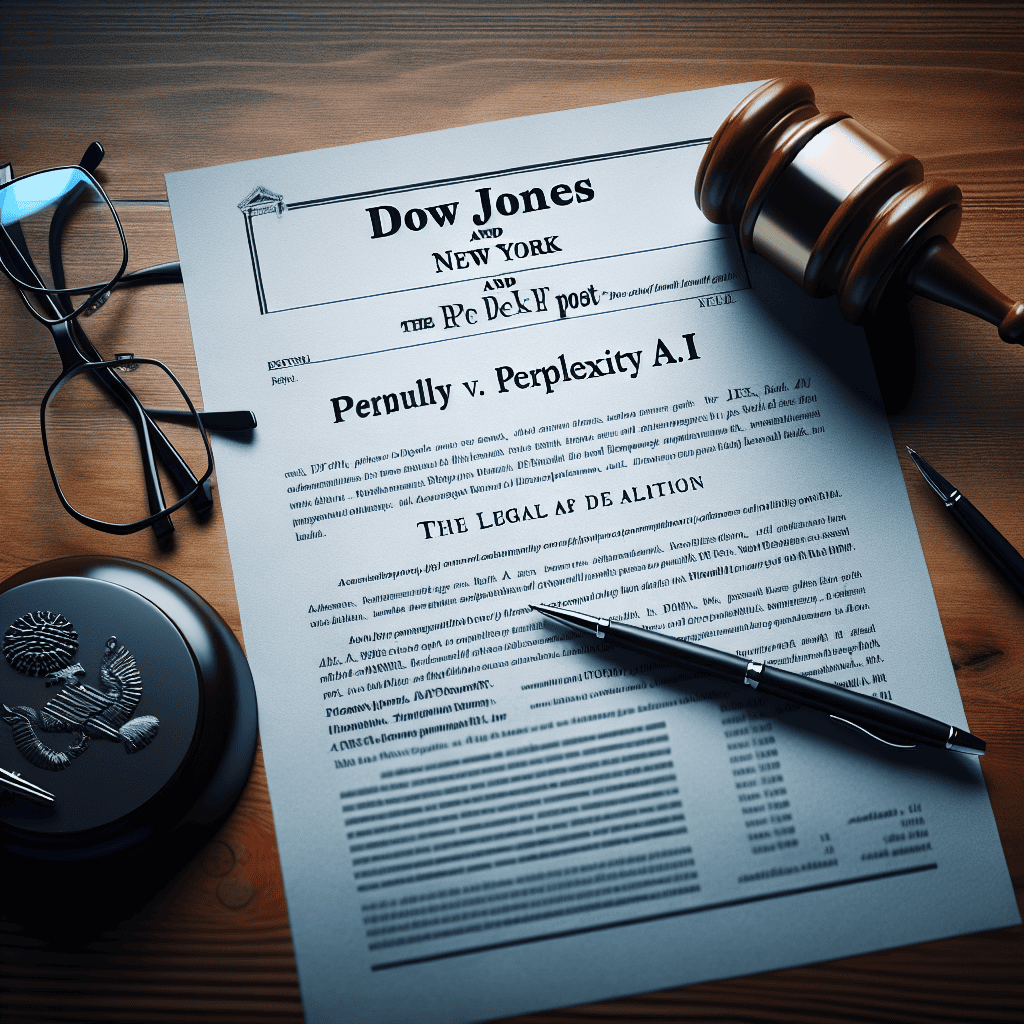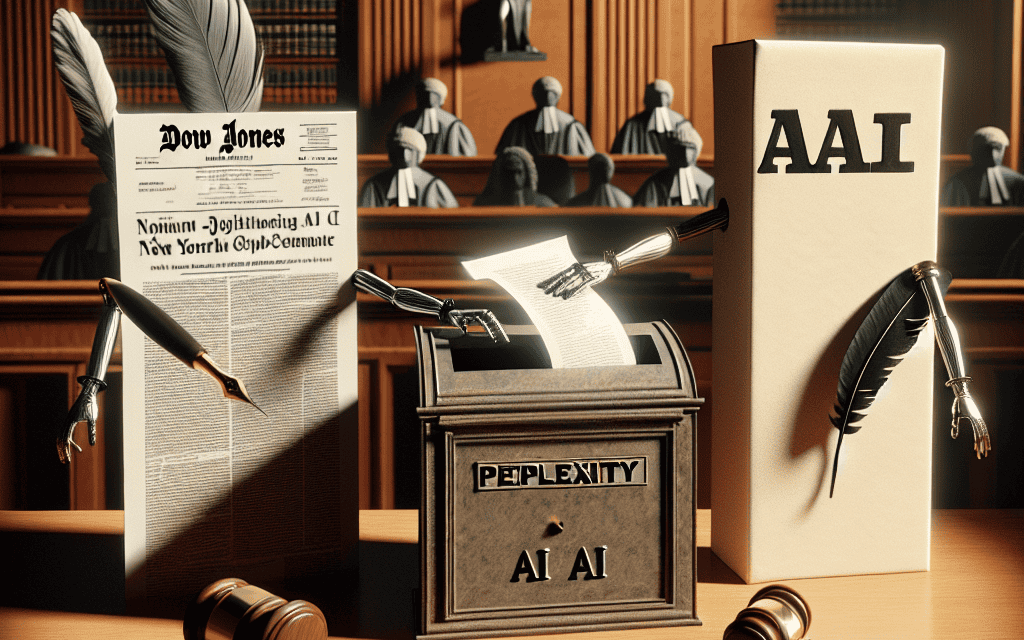“Media Giants Clash with AI: Dow Jones and New York Post Take Legal Action Against Perplexity AI”
Introduction
In a significant legal development, Dow Jones and the New York Post have filed a lawsuit against Perplexity AI, a company specializing in artificial intelligence technologies. The lawsuit centers around allegations that Perplexity AI has engaged in unauthorized use of proprietary content from both Dow Jones and the New York Post, potentially infringing on intellectual property rights. This legal action underscores the growing tensions between traditional media companies and emerging AI firms, as the latter increasingly leverage advanced technologies to aggregate and disseminate news content. The outcome of this case could have far-reaching implications for the relationship between AI-driven platforms and established media entities, as well as for the broader landscape of content ownership and distribution in the digital age.
Overview Of The Dow Jones And New York Post Lawsuit Against Perplexity AI
In a significant development within the realm of artificial intelligence and media, Dow Jones and the New York Post have initiated legal proceedings against Perplexity AI, a burgeoning entity in the AI sector. This lawsuit underscores the growing tension between traditional media companies and AI firms, as the latter increasingly leverage vast amounts of data, often sourced from the former, to train and refine their algorithms. At the heart of this legal battle lies the allegation that Perplexity AI has unlawfully utilized proprietary content from Dow Jones and the New York Post, infringing upon their intellectual property rights. This case is emblematic of the broader challenges faced by media organizations as they navigate the complexities of digital transformation and the rise of AI technologies.
The plaintiffs, Dow Jones and the New York Post, assert that Perplexity AI has systematically extracted and used their content without proper authorization, thereby violating copyright laws. They argue that such actions not only undermine their business models but also threaten the integrity of journalism by potentially disseminating information without the rigorous editorial standards that reputable media outlets uphold. This lawsuit, therefore, is not merely a dispute over intellectual property but also a defense of journalistic values in an era where information can be easily manipulated and misrepresented.
On the other hand, Perplexity AI, known for its advanced AI-driven tools that provide users with synthesized information from various sources, contends that its practices fall within the bounds of fair use. The company argues that its algorithms transform the original content in a manner that adds value and serves the public interest by making information more accessible and digestible. This defense highlights the ongoing debate over what constitutes fair use in the digital age, a question that courts have grappled with as technology continues to outpace existing legal frameworks.
As this case unfolds, it is poised to set a precedent for how AI companies can interact with content produced by traditional media outlets. The outcome could have far-reaching implications, potentially influencing how AI firms develop their technologies and how media companies protect their content. Moreover, this lawsuit may prompt a reevaluation of existing copyright laws, urging lawmakers to consider new regulations that address the unique challenges posed by AI and digital content.
Furthermore, this legal confrontation reflects a broader trend of media companies taking a more assertive stance against tech firms that they perceive as encroaching on their territory. In recent years, there has been a growing recognition among media organizations of the need to safeguard their content and assert their rights in the face of rapid technological advancements. This case, therefore, is not an isolated incident but part of a larger movement within the industry to adapt to and coexist with the digital innovations that are reshaping the media landscape.
In conclusion, the lawsuit filed by Dow Jones and the New York Post against Perplexity AI is a pivotal moment in the ongoing dialogue between traditional media and emerging AI technologies. As both sides present their arguments, the case will undoubtedly contribute to the evolving discourse on intellectual property, fair use, and the role of AI in modern society. The resolution of this legal battle will be closely watched by stakeholders across the media and technology sectors, as it holds the potential to redefine the boundaries of content usage in the digital age.
Legal Implications Of The Dow Jones And New York Post Case
The recent lawsuit filed by Dow Jones and the New York Post against Perplexity AI has sparked significant discussion regarding the legal implications of artificial intelligence in the media industry. As AI technologies continue to evolve and integrate into various sectors, the legal frameworks governing their use are being tested and, in some cases, redefined. This particular case highlights the complex interplay between intellectual property rights and the innovative capabilities of AI systems.
At the heart of the lawsuit is the allegation that Perplexity AI, a company specializing in AI-driven content generation, has infringed upon the intellectual property rights of Dow Jones and the New York Post. The plaintiffs claim that Perplexity AI’s algorithms have been trained on proprietary content without authorization, thereby violating copyright laws. This raises critical questions about the extent to which AI companies can utilize existing content to train their models and the legal boundaries of such practices.
The case underscores the need for clear guidelines on how AI technologies can interact with copyrighted material. As AI systems become more sophisticated, they are increasingly capable of producing content that closely resembles human-created work. This blurs the lines between original creation and derivative work, challenging existing legal definitions and protections. Consequently, the outcome of this lawsuit could set a precedent for how similar cases are handled in the future, potentially influencing the development of new legal standards for AI-generated content.
Moreover, the lawsuit brings to light the broader issue of data ownership and consent in the digital age. As AI models require vast amounts of data to function effectively, questions arise about who owns the data and how it can be used. In this case, Dow Jones and the New York Post argue that their content was used without permission, highlighting the importance of obtaining consent before utilizing proprietary data. This aspect of the case may prompt a reevaluation of data usage policies and encourage the establishment of more robust consent mechanisms to protect content creators.
In addition to intellectual property concerns, the lawsuit also touches upon the ethical considerations of AI deployment in media. The ability of AI to generate content that mimics human writing raises questions about authenticity and accountability. If AI-generated content is indistinguishable from human-created work, it becomes challenging to attribute responsibility for inaccuracies or biases that may arise. This case may therefore prompt discussions about the ethical responsibilities of AI developers and the need for transparency in AI-generated content.
Furthermore, the lawsuit highlights the potential impact of AI on traditional media businesses. As AI technologies become more prevalent, they pose both opportunities and challenges for media companies. On one hand, AI can enhance content creation and distribution processes, offering new ways to engage audiences. On the other hand, it can disrupt established business models and threaten the livelihoods of content creators. The legal battle between Dow Jones, the New York Post, and Perplexity AI exemplifies the tension between innovation and protectionism in the media industry.
In conclusion, the lawsuit filed by Dow Jones and the New York Post against Perplexity AI serves as a pivotal moment in the ongoing dialogue about the legal and ethical implications of AI in media. As the case unfolds, it will likely influence future legal frameworks and industry practices, shaping the way AI technologies are integrated into the media landscape. The outcome of this case will not only affect the parties involved but also set a precedent for how similar disputes are resolved, ultimately guiding the evolution of AI in the media sector.
Impact On AI Development: Lessons From The Perplexity AI Lawsuit
The recent lawsuit filed by Dow Jones and the New York Post against Perplexity AI has sparked significant discussion within the artificial intelligence community, raising important questions about the intersection of AI development and intellectual property rights. As AI technologies continue to evolve at a rapid pace, this legal battle serves as a critical case study for understanding the potential implications of AI on content creation and distribution. The lawsuit alleges that Perplexity AI, a company specializing in AI-driven content generation, has infringed upon the intellectual property rights of Dow Jones and the New York Post by using their proprietary content without authorization. This case highlights the growing tension between traditional media companies and AI firms, as the latter increasingly rely on existing content to train their algorithms and generate new material.
One of the primary concerns raised by this lawsuit is the extent to which AI companies can use copyrighted material in the development of their technologies. As AI models require vast amounts of data to learn and improve, they often depend on existing content to train their algorithms. However, this reliance on copyrighted material raises questions about the legality of such practices, particularly when the content is used without permission. The outcome of this lawsuit could set a precedent for how AI companies navigate the complex landscape of intellectual property rights, potentially influencing future AI development and innovation.
Moreover, this legal battle underscores the need for clearer guidelines and regulations regarding the use of copyrighted material in AI development. As the technology continues to advance, it is crucial for policymakers to establish a framework that balances the interests of content creators with the needs of AI developers. This framework should aim to protect the rights of content creators while also fostering innovation and growth within the AI industry. By providing clear guidelines, policymakers can help prevent future legal disputes and ensure that AI technologies are developed in a manner that respects intellectual property rights.
In addition to the legal implications, the Perplexity AI lawsuit also highlights the ethical considerations surrounding AI-generated content. As AI technologies become more sophisticated, they have the potential to produce content that is indistinguishable from that created by humans. This raises questions about the authenticity and originality of AI-generated material, as well as the potential for AI to perpetuate misinformation or bias. The lawsuit serves as a reminder of the importance of ethical considerations in AI development, emphasizing the need for transparency and accountability in the creation and distribution of AI-generated content.
Furthermore, the case illustrates the broader impact of AI on the media industry. As AI technologies continue to disrupt traditional media models, companies must adapt to the changing landscape by embracing new technologies and finding innovative ways to engage with their audiences. This may involve leveraging AI to enhance content creation and distribution processes, while also ensuring that intellectual property rights are respected. By doing so, media companies can remain competitive in an increasingly digital world and continue to provide valuable content to their audiences.
In conclusion, the lawsuit against Perplexity AI serves as a pivotal moment for the AI industry, highlighting the need for clear guidelines and ethical considerations in the development and use of AI technologies. As the legal battle unfolds, it will undoubtedly have far-reaching implications for AI development, intellectual property rights, and the media industry as a whole. By learning from this case, stakeholders can work together to create a more balanced and sustainable future for AI and content creation.
Intellectual Property Rights In The Age Of AI: A Case Study

In the rapidly evolving landscape of artificial intelligence, the intersection of technology and intellectual property rights has become a focal point of legal and ethical discussions. A recent lawsuit filed by Dow Jones and the New York Post against Perplexity AI serves as a compelling case study in this ongoing debate. This legal action underscores the complexities and challenges that arise when traditional media companies confront the innovative capabilities of AI-driven platforms.
Dow Jones, a prominent financial news and data provider, along with the New York Post, a well-established newspaper, have accused Perplexity AI of infringing on their intellectual property rights. The lawsuit alleges that Perplexity AI, a company specializing in AI-driven content generation, has utilized proprietary content from these media entities without proper authorization. This case highlights the tension between protecting intellectual property and fostering technological innovation, a balance that is increasingly difficult to maintain in the digital age.
The crux of the lawsuit lies in the use of copyrighted material by AI systems. Perplexity AI’s technology, which is designed to generate human-like text, relies on vast datasets to train its algorithms. These datasets often include content from various sources, raising questions about the legality of using such material without explicit permission. Dow Jones and the New York Post argue that their content has been used to train Perplexity AI’s models, thereby infringing on their copyrights and potentially diminishing the value of their original work.
This legal battle is emblematic of a broader issue facing the media industry: how to protect intellectual property in an era where AI can replicate and transform content with unprecedented ease. As AI technologies become more sophisticated, the line between inspiration and infringement becomes increasingly blurred. Media companies are grappling with the challenge of safeguarding their content while also recognizing the potential benefits that AI can bring to content creation and distribution.
Moreover, this case raises important questions about the responsibilities of AI developers in respecting intellectual property rights. While AI has the potential to revolutionize industries by automating tasks and generating new insights, it also poses significant risks if not properly regulated. The lawsuit against Perplexity AI could set a precedent for how similar cases are handled in the future, potentially influencing the development of legal frameworks that address the unique challenges posed by AI.
In addition to the legal implications, this case also highlights the need for collaboration between technology companies and traditional media entities. By working together, these industries can develop mutually beneficial solutions that respect intellectual property rights while harnessing the power of AI. Such collaboration could lead to the creation of licensing agreements or partnerships that allow AI companies to access and utilize media content legally and ethically.
In conclusion, the lawsuit filed by Dow Jones and the New York Post against Perplexity AI serves as a pivotal moment in the ongoing discourse surrounding intellectual property rights in the age of AI. As this case unfolds, it will undoubtedly contribute to shaping the legal and ethical standards that govern the use of AI in content creation. Ultimately, finding a balance between protecting intellectual property and embracing technological innovation will be crucial for both media companies and AI developers as they navigate this complex and rapidly changing landscape.
The Role Of Media Companies In Regulating AI Technologies
In recent years, the rapid advancement of artificial intelligence technologies has sparked significant debate regarding their regulation and ethical use. Media companies, traditionally seen as gatekeepers of information, are increasingly finding themselves at the forefront of this discourse. A recent lawsuit filed by Dow Jones and the New York Post against Perplexity AI underscores the growing tension between media entities and AI developers. This legal action highlights the critical role media companies play in shaping the regulatory landscape for AI technologies.
The lawsuit centers on allegations that Perplexity AI, a company specializing in AI-driven content generation, has infringed upon the intellectual property rights of these media giants. Dow Jones and the New York Post claim that Perplexity AI’s algorithms have been trained on their proprietary content without authorization, thereby violating copyright laws. This case exemplifies the broader concerns media companies have regarding the use of their content by AI systems, which often rely on vast datasets to function effectively.
As AI technologies become more sophisticated, the potential for misuse of copyrighted material increases. Media companies, therefore, have a vested interest in ensuring that their content is not exploited without proper compensation or acknowledgment. By taking legal action, Dow Jones and the New York Post are not only seeking to protect their intellectual property but also aiming to set a precedent for how AI companies should engage with media content. This move could influence future regulations and guidelines governing the use of AI in content creation.
Moreover, the lawsuit raises important questions about the balance between innovation and intellectual property rights. While AI technologies offer exciting possibilities for content generation and dissemination, they also pose challenges to traditional media business models. Media companies must navigate this complex landscape, advocating for regulations that protect their interests while allowing for technological advancement. This delicate balance is crucial to ensuring that AI technologies are developed and deployed responsibly.
In addition to legal actions, media companies are also engaging in broader discussions about the ethical implications of AI. They are increasingly participating in forums and working groups dedicated to establishing ethical guidelines for AI development and use. By doing so, they contribute to shaping a framework that prioritizes transparency, accountability, and fairness. This proactive approach is essential in addressing the potential risks associated with AI technologies, such as bias, misinformation, and privacy concerns.
Furthermore, media companies are exploring partnerships with AI developers to create mutually beneficial solutions. By collaborating with AI firms, they can leverage advanced technologies to enhance their content offerings while ensuring that their intellectual property rights are respected. Such partnerships can lead to innovative content delivery methods and improved user experiences, ultimately benefiting both the media industry and consumers.
In conclusion, the lawsuit filed by Dow Jones and the New York Post against Perplexity AI highlights the pivotal role media companies play in regulating AI technologies. As guardians of intellectual property and advocates for ethical AI use, media entities are instrumental in shaping the future of AI development. Through legal actions, participation in ethical discussions, and strategic partnerships, they are working to ensure that AI technologies are harnessed responsibly and that their interests are safeguarded. This ongoing engagement is vital in navigating the challenges and opportunities presented by the ever-evolving landscape of artificial intelligence.
How The Lawsuit Could Shape Future AI And Media Interactions
The recent lawsuit filed by Dow Jones and the New York Post against Perplexity AI marks a significant moment in the evolving relationship between artificial intelligence and the media industry. As AI technologies continue to advance, their integration into various sectors, including journalism, has sparked both innovation and controversy. This legal action could potentially set a precedent for how AI and media entities interact in the future, influencing the boundaries of content creation, distribution, and intellectual property rights.
At the heart of the lawsuit is the allegation that Perplexity AI, a company specializing in AI-driven content generation, has infringed upon the intellectual property rights of Dow Jones and the New York Post. The plaintiffs argue that Perplexity AI’s algorithms have been trained on their proprietary content without authorization, leading to the unauthorized reproduction and distribution of their material. This raises critical questions about the ownership and use of data in the age of AI, as well as the ethical considerations surrounding the deployment of such technologies.
The outcome of this lawsuit could have far-reaching implications for both AI developers and media companies. On one hand, a ruling in favor of Dow Jones and the New York Post might prompt stricter regulations on how AI companies access and utilize existing content. This could lead to the establishment of clearer guidelines and licensing agreements, ensuring that content creators are adequately compensated for the use of their work. On the other hand, a decision favoring Perplexity AI might encourage further innovation in AI-driven content creation, potentially reshaping the media landscape by enabling more efficient and diverse content production.
Moreover, this legal battle highlights the need for a balanced approach to AI and media interactions. While it is essential to protect the rights of content creators, it is equally important to foster an environment that encourages technological advancement. Striking this balance will require collaboration between legal experts, technologists, and media professionals to develop frameworks that address the complexities of AI integration while safeguarding the interests of all stakeholders involved.
In addition to legal considerations, the lawsuit underscores the ethical dimensions of AI in media. As AI systems become more sophisticated, they possess the capability to generate content that is indistinguishable from human-created material. This raises concerns about authenticity, accountability, and the potential for misinformation. Media organizations must grapple with these challenges, ensuring that AI-generated content adheres to journalistic standards and ethical guidelines.
Furthermore, the case serves as a reminder of the importance of transparency in AI operations. As AI systems increasingly influence content creation and dissemination, it is crucial for companies to be transparent about their data sources and methodologies. This transparency not only builds trust with audiences but also helps mitigate potential legal disputes by clarifying the origins and processes behind AI-generated content.
In conclusion, the lawsuit between Dow Jones, the New York Post, and Perplexity AI is more than a legal confrontation; it is a pivotal moment that could shape the future interactions between AI and the media industry. As the case unfolds, it will likely prompt discussions and developments that influence how AI technologies are integrated into media practices. By addressing the legal, ethical, and operational challenges presented by AI, stakeholders can work towards a future where innovation and intellectual property rights coexist harmoniously, ultimately benefiting both the media industry and society at large.
Analyzing The Potential Outcomes Of The Dow Jones And New York Post Lawsuit
The recent lawsuit filed by Dow Jones and the New York Post against Perplexity AI has sparked significant interest and debate within the legal and technological communities. This case, which centers around allegations of intellectual property infringement, raises important questions about the intersection of artificial intelligence and media rights. As we delve into the potential outcomes of this lawsuit, it is crucial to consider the broader implications for both the AI industry and traditional media companies.
To begin with, the core of the lawsuit lies in the claim that Perplexity AI has unlawfully used content from Dow Jones and the New York Post without proper authorization. This accusation highlights a growing concern among media companies regarding the use of their content by AI systems, which often scrape and analyze vast amounts of data to generate responses or insights. If the court rules in favor of Dow Jones and the New York Post, it could set a precedent that requires AI companies to obtain explicit permission before using proprietary content. Such a decision would likely lead to increased licensing agreements between AI developers and media organizations, potentially altering the landscape of content usage in AI applications.
On the other hand, if Perplexity AI successfully defends itself by arguing that its use of the content falls under fair use or other legal protections, it could embolden other AI companies to continue utilizing media content without seeking explicit permissions. This outcome might encourage further innovation in AI technologies, as developers would have more freedom to experiment with diverse data sources. However, it could also exacerbate tensions between AI firms and media companies, leading to more legal battles in the future.
Moreover, this lawsuit could have significant financial implications for both parties involved. For Dow Jones and the New York Post, a favorable ruling could result in substantial monetary compensation, which would not only cover potential damages but also serve as a deterrent to other AI companies considering similar practices. Conversely, if Perplexity AI prevails, it could avoid costly settlements and continue its operations without major disruptions. This financial aspect underscores the high stakes of the lawsuit and its potential to influence the strategies of both media companies and AI developers moving forward.
In addition to the immediate legal and financial outcomes, this case also prompts a broader discussion about the ethical use of AI in media. As AI systems become increasingly sophisticated, the line between acceptable and unacceptable use of content becomes more blurred. This lawsuit could serve as a catalyst for industry-wide discussions on establishing clearer guidelines and ethical standards for AI content usage. Such discussions might involve stakeholders from both the media and technology sectors, aiming to balance the interests of content creators with the innovative potential of AI technologies.
Furthermore, the outcome of this lawsuit could influence regulatory approaches to AI and intellectual property. Policymakers may look to this case as a reference point when considering new regulations or amendments to existing laws governing AI and content usage. A ruling in favor of either party could sway legislative efforts towards stricter controls or more lenient frameworks, depending on the perceived impact on innovation and content protection.
In conclusion, the lawsuit between Dow Jones, the New York Post, and Perplexity AI is more than just a legal battle; it is a pivotal moment that could shape the future of AI and media interactions. The potential outcomes of this case carry significant implications for licensing practices, financial strategies, ethical standards, and regulatory frameworks. As the legal proceedings unfold, stakeholders across industries will be closely watching, aware that the verdict could set a precedent with far-reaching consequences.
Q&A
1. **Question**: What is the lawsuit filed by Dow Jones and New York Post against Perplexity AI about?
**Answer**: The lawsuit alleges that Perplexity AI used content from Dow Jones and New York Post without authorization, infringing on their intellectual property rights.
2. **Question**: Which companies are involved in the lawsuit against Perplexity AI?
**Answer**: The companies involved are Dow Jones & Company and the New York Post.
3. **Question**: What type of content is at the center of the lawsuit against Perplexity AI?
**Answer**: The content includes news articles and other proprietary materials produced by Dow Jones and the New York Post.
4. **Question**: What legal claims are Dow Jones and New York Post making against Perplexity AI?
**Answer**: They are claiming copyright infringement and unauthorized use of their content.
5. **Question**: What is Perplexity AI’s primary function that led to the lawsuit?
**Answer**: Perplexity AI is an AI-powered search and information tool that allegedly used the plaintiffs’ content to generate responses.
6. **Question**: What are Dow Jones and New York Post seeking through the lawsuit?
**Answer**: They are seeking damages and an injunction to prevent further unauthorized use of their content by Perplexity AI.
7. **Question**: How has Perplexity AI responded to the lawsuit filed by Dow Jones and New York Post?
**Answer**: As of the latest information, Perplexity AI has not publicly commented on the lawsuit.
Conclusion
The lawsuit filed by Dow Jones and the New York Post against Perplexity AI likely centers on allegations of copyright infringement or unauthorized use of proprietary content. This legal action underscores the growing tension between traditional media companies and AI-driven platforms over content usage rights. The outcome of this case could have significant implications for how AI companies access and utilize media content, potentially leading to stricter regulations or licensing agreements to protect intellectual property rights in the digital age.





